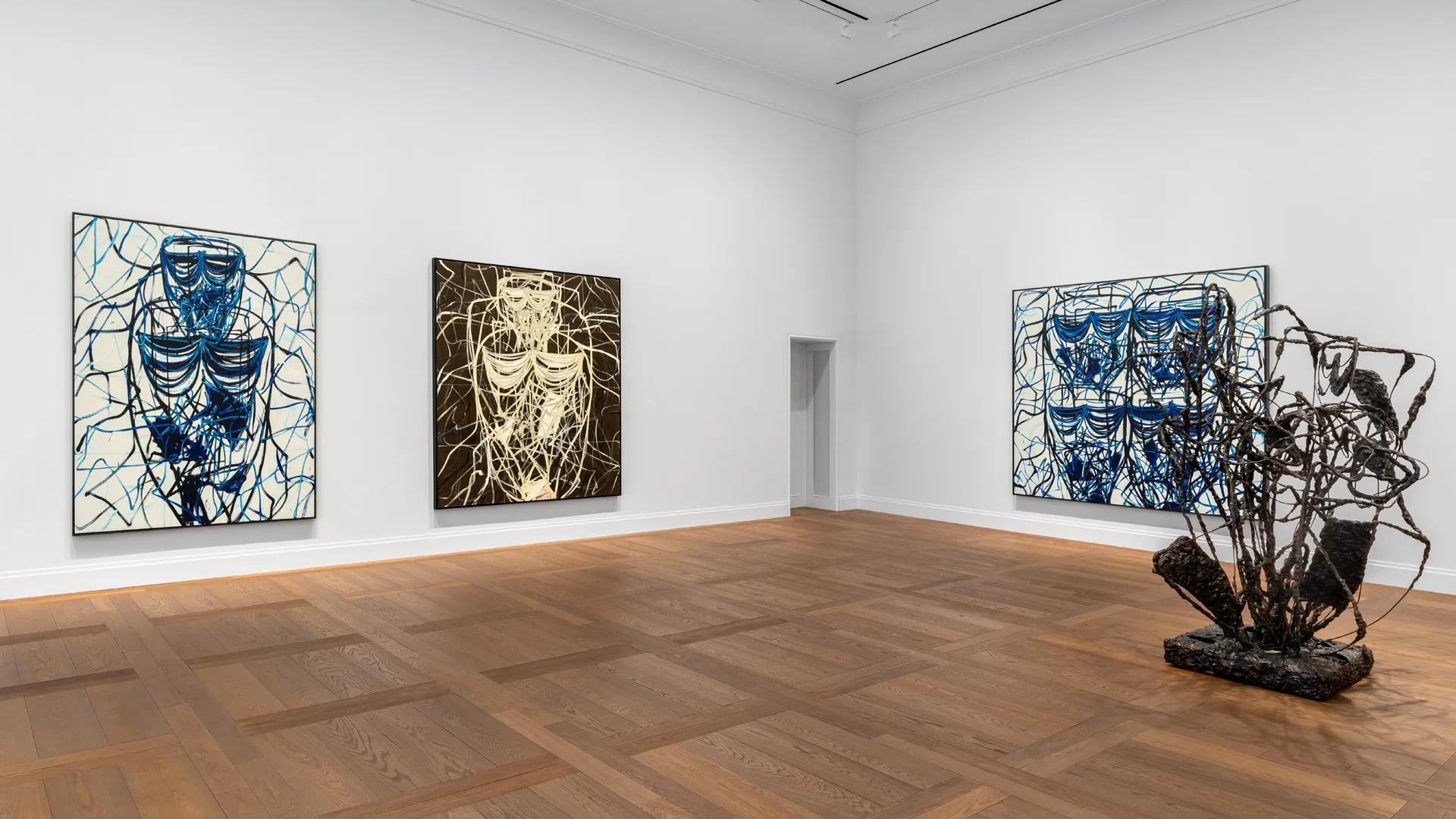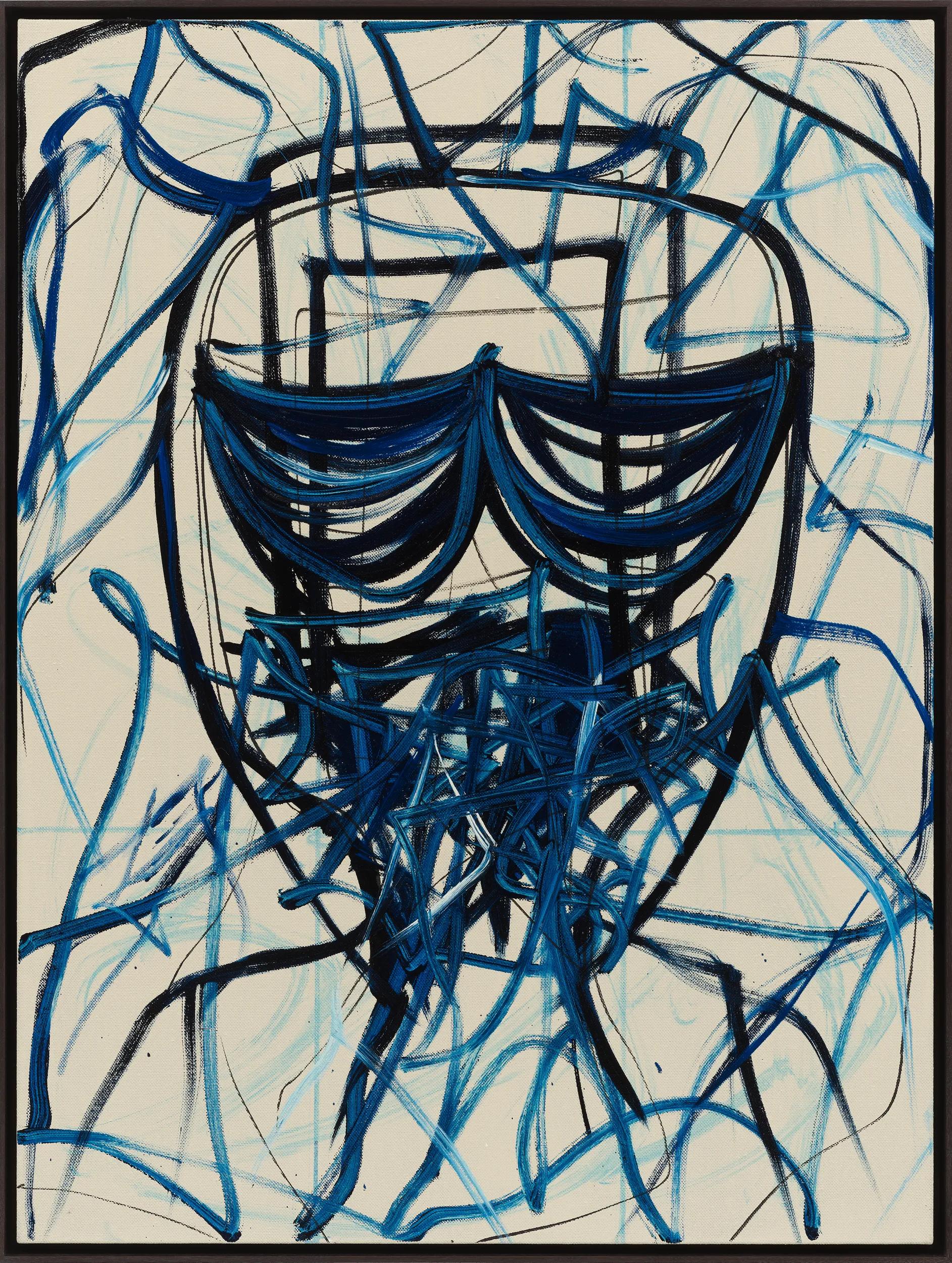Coinciding with Art Basel Paris 2024, ‘Anima’ presents Rashid Johnson’s latest work, spanning painting, sculpture and film, which demonstrates the artist’s longstanding interest in the concepts of interiority and self-reflection.
Continuing to expand Johnson’s distinctive visual lexicon, this exhibition exemplifies the artist’s interest in animism, the belief in which all things, including inanimate objects, have souls. The exhibition marks the gallery debut of two new bodies of painting, the closely related Soul Paintings and God Paintings, both series that Johnson has developed over the past several years. Alongside and evolving out of the works on canvas are two new series of bronze sculptures, their roughly-modeled surfaces bearing witness to the artist’s hand in a way that has dominated his sculptural practice in recent years. Also on display is his latest film, ‘Sanguine,’ exploring relationships of attention and care among three generations of the artist’s family: his father, himself and his son. Sanguine can be a perspective, often marked by hopefulness and optimism, or a color, blood-red; both definitions apply to the film ‘Sanguine’ (2024) by Rashid Johnson.
Sanguine as a characteristic is evident in the many moments when the characters are engaged in deep interior thought. The audience are not privy to their inner dialogue but are able to witness the outer expression of it. The color sanguine became important to Johnson years ago when he was negotiating his relationship to a higher power, deciding that the red he saw when his eyes were closed would be his stand in for ‘god’. In the film, the divine and anima in all things is a strong undertone. Recurring throughout the film is the shape the vesica piscis, which is presented over a blood-red backdrop. Representing the space between two concentric circles, this shape is a formal representation of liminality for Johnson. ‘Sanguine’ in many ways is a filmic exploration of liminal space.

Through the concept of animism, the artist connects to a reality beyond the physical, building an expansive vision of the universe in which all objects, including the paintings and sculptures on view, are imbued with spiritual life. The exhibition title, ‘Anima,’ hints at Johnson’s continued interrogation, through his oeuvre, of the liminal space between body and soul. As part of his interior investigation, the artist cites Kevin Quashie’s ‘The Sovereignty of Quiet,’ a book which explores quiet as a different kind of expressiveness, one which characterizes a person’s desires, ambitions, hungers, vulnerabilities and fears. As Johnson says, ‘I was thinking about this idea of warmth, the idea of vulnerability, and how one begins the process of illustrating the soul.’
‘Interiority has always been essential in my project ... There’s a sense of soul searching, a sense of intimacy that is necessary for me to explore.’—Rashid Johnson

Throughout the exhibition, Johnson returns to an iconic form within his visual language, the evocative almond-shaped vesica piscis, a leitmotif that has been in use in visual culture around the world since humanity’s earliest days. Employed horizontally in the Soul Paintings, the abstract form takes on a representational, biological quality, suggesting mask-like cranial forms, eyes and skeletal pectorals. Representing the intersection between two overlapping circles, the vesica piscis motif is employed by Johnson as an expression of liminality, an acknowledgment of what we feel but cannot explain.

Employed vertically in the deeply personal God Paintings, this form—carved into the canvas’s thick coat of red oil paint using a brush and palette knife—takes on a ritualistic, meditative quality, its constant repetition evoking a mantra, familiar from a number of diverse material cultures. The artist harnesses these evocative motifs to capture and examine his spiritual journey, and the exhibition invites viewers to embark on their own.
‘I was thinking about this idea of warmth, the idea of vulnerability, and how one begins the process of illustrating the soul.’—Rashid Johnson

The structure of the paintings conveys Johnson’s interest in multiplicity, the process of repetition and layering, and the line, using techniques such as wet-on-wet painting, to create a multitude of intersections and meanings. At other times, the artist waits for the paintings to dry before continuing, allowing for a necessary moment of pause and reflection during which energy is gained and then transferred into mark-making. As Johnson says, ‘I’ve always had a real enthusiasm for, for multiple exposure, how an image can be made, and another image can then live on the surface of that image.’ This process of layering can be considered in multiple different ways: as a collage, a connection to another-, or a collision.

In the paintings on view, Johnson employs a colour palette of deep reds and blues, alongside new shades of creamy off-whites and earthy browns. The artist intentionally makes minor adjustments to his neutral colour palette in works such as ‘Soul Painting “Nobody”’ (2024) and ‘Soul Painting “I Feel For You”’ (2024). In doing so, he views colour as analogous to the idea of collectivisation, where small differences can make the works ideologically very different, whilst also containing many shared characteristics. Johnson also continues to engage with his chosen material’s narrative power, previously using materials such as shea butter and black soap to draw on and highlight the importance of their charged histories. In this body of paintings, Johnson shifts towards the canonically significant and universally recognisable medium of oil paint to explore the antecedent concerns and values that many artists have faced throughout history in using this medium.

A selection of new bronze sculptures features an array of objects of symbolic significance, such as shells, buried into the roughly modelled clay from which they are cast. Within the group of Standing Soul Sculptures, Johnson has used wire forms as part of the casting process to create a sense of freehand, exploring a freedom in the composition akin to his use of the line in the paintings. Another series of cast bronze sculptures take the form of chairs; these ‘chairs’ are installed in a circle facing inwards within the gallery space and imply an intimate group meeting. Johnson frequently uses familiar objects in composite works—a process he refers to as ‘hijacking the domestic’—to convey notions of shared experience. Exploring at once the soul and collective histories, Johnson’s works in ‘Anima’ are deeply personal and vulnerable yet universal and rich with symbolism.
Carbon savings
Part of this exhibition was shipped by sea from the USA. Transport by sea versus air resulted in a carbon saving of 35.66 tCO2e. This saving is equivalent to 22 return flights between New York and Paris.

On View in Paris
‘Rashid Johnson. Anima’ is on view through 21 December. The gallery is open Tuesday – Saturday, 10 am – 6 pm. Exhibitions are free to attend. No advance booking necessary.
關於藝術家

Rashid Johnson
Inquire about other available works by Rashid Johnson
Current Exhibitions
1 / 12

























